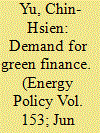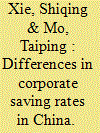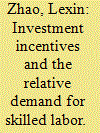|
|
|
Sort Order |
|
|
|
Items / Page
|
|
|
|
|
|
|
| Srl | Item |
| 1 |
ID:
187868


|
|
|
|
|
| Summary/Abstract |
Based on microdata from China's listed companies and macrodata for broadband internet access in prefecture-level cities, this paper explores the relationship between broadband internet and enterprise innovation. Using the change in market concentration caused by the North–South separation reform of China Telecom in 2002 as an instrumental variable, the results show that in general, a 1% increase in broadband internet access results in a 1.395% increase in the number of corporate patents. Specifically, the number of valid patents, patent citations and valid patent citations, reflecting patent quality, increases by 1.499%, 0.920% and 0.763%, respectively. The mechanistic analysis shows that broadband internet access contributes to increasing the number of R&D personnel and personal innovation efficiency, enhancing enterprises' willingness to innovate, and easing financing constraints. Further analysis suggests that broadband internet access mainly promotes invention patents rather than design patents. The innovation effect is more evident among high-tech, inventor-intensive, state-owned enterprises and enterprises located in the non-southeastern coastal region of China.
|
|
|
|
|
|
|
|
|
|
|
|
|
|
|
|
| 2 |
ID:
178842


|
|
|
|
|
| Summary/Abstract |
This paper investigates the effects of financing constraints on prompting green innovations using a sample of Chinese listed firms in the period 2001–2017. Also, we explore how green finance policies resolve financing constraints of firms to green innovation. The capability of green innovation is found to be impaired when firms face higher financing constraints, and privately owned enterprises tend to be more vulnerable than state-owned ones in this regard. Although green finance policies can effectively ease financing restraints on green innovation overall, green credits are less likely to be available to privately owned enterprises. However, these enterprises which are deeply affected by financing constraints have relatively high innovation capabilities. We suggest the government to provide more supports to privately owned enterprises for investing in green projects. Further, both financial institutions and privately owned enterprises should be required to disclose more information on green credits and green projects, respectively. In addition, the China Banking Regulatory Commission should design a synthetic mechanism for evaluating green performance.
|
|
|
|
|
|
|
|
|
|
|
|
|
|
|
|
| 3 |
ID:
143431


|
|
|
|
|
| Summary/Abstract |
Using the data of the listed non-financial companies from 2003 to 2012, this paper conducts a firm-level empirical analysis to reveal the determinants that lead to differences in saving rates of different enterprises in China. Particularly, we explore the discrepancies in the Chinese enterprises' saving rates from the new perspectives of ownership type, monopoly status, and financial development. We find that only some financial indicators of a firm, including the size and the long-term solvency ability, have direct impact on its saving rate. Besides, the difference in the saving rates between private firms and state-owned firms is insignificant while monopolies have higher saving rates than non-monopolies. Most importantly, financial development generally reduces a firm's saving rate and the impact is independent on its ownership type and monopoly status. Moreover, financial development decreases the influence of a firm's short-term solvency and profitability on its saving rate.
|
|
|
|
|
|
|
|
|
|
|
|
|
|
|
|
| 4 |
ID:
112734


|
|
|
|
|
| Publication |
2012.
|
| Summary/Abstract |
This paper examines the impact of recent financial reforms in China on the financing constraints and investment of publicly-listed Chinese firms. Two continuous indices are constructed to measure the evolution and intensity of financial reforms: a financial liberalization index and a capital control index. Dynamic panel GMM method is used to estimate firms' financing constraints in an Euler-equation investment model. Based on panel data of listed firms for 1996-2007, we find that large firms face no credit constraints and smaller firms display significant constraints. However, the sensitivity of large firms' investment to their cash holdings is heightened as more financial reforms take place. It appears that reforms that gradually eliminate preferential treatments to large firms, primarily state-owned enterprises (SOEs) in China, have subjected these firms' investment decisions to stricter market-based discipline and therefore raised their financing constraints. No significant change in the financing constraint is detected for smaller firms in China. This is interpreted as financial reform in China has not been substantial enough for its benefits to reach smaller firms.
|
|
|
|
|
|
|
|
|
|
|
|
|
|
|
|
| 5 |
ID:
156455


|
|
|
|
|
| Summary/Abstract |
This study investigates the influence of the financial system on firms' investment efficiency in China. For this purpose, we employ country level data of capital markets and financial institutions along with financial data from 2797 Chinese firms in the period from 1998 to 2015. The firms are priori classified into four groups, by high and low values of financial constraints and agency problems. Results show that financial development influences firms' investments positively either directly or by reducing cash flow sensitivity. The impact remains the same for all types of firms. Moreover, the financial structure has an impact on investment efficiency of firms; this result also remains the same even after controlling levels of financial development. Study contributes that capital market based financial structure impacts investment decisions by reducing financing constraints and agency issue due to its strong monitoring ability.
|
|
|
|
|
|
|
|
|
|
|
|
|
|
|
|
| 6 |
ID:
187858


|
|
|
|
|
| Summary/Abstract |
This study evaluates the effects of China's 2014 and 2015 accelerated depreciation policies on the relative demand of firms for skilled labor. We develop a simple model to explore how the policies affect the relative demand of firms for skilled labor and illustrate the roles of financing constraints and tax compliance in mediating the policy effects. We then employ a firm-level dataset from China's A-share listed companies and use a quasi-experimental design to examine the model predictions. We find that the policies significantly increase the relative demand of firms for skilled labor. The channels underlying the policy effects are that the policies generate additional cash flow for firms, stimulate investment and, thus, raise the demand of firms for skilled labor with the presence of capital–skill complementarity. We also find that the positive effects of the policies on the relative demand for skilled labor are primarily significant for firms with strong financing constraints and high tax compliance. Moreover, we document the positive effects of the policies on R&D investment, firm value added, productivity, workers' benefits, and corporate social responsibility performance, which further corroborate our main results.
|
|
|
|
|
|
|
|
|
|
|
|
|
|
|
|
| 7 |
ID:
161769


|
|
|
|
|
| Summary/Abstract |
We hypothesize that research and development (R&D) is sensitive to cash flow fluctuations due to asymmetric information and agency problems in the credit market. We adopt a variant of the Q model for R&D investment using the value of the firm, physical capital and employment to capture firm fundamentals as proxies for investment opportunities. We add cash flow to this specification, and estimate the augmented model separately for R&D participation and spending decisions using data on Chinese industrial firms for the period 2001–2006. We find that R&D participation and spending are sensitive to cash flow fluctuations, conditional on firm fundamentals. We also find that the cash flow sensitivity of R&D varies across firms depending on ownership.
|
|
|
|
|
|
|
|
|
|
|
|
|
|
|
|
| 8 |
ID:
161779


|
|
|
|
|
| Summary/Abstract |
This paper provides a theoretical and empirical analysis of the effects of R&D and financing constraints on the green-sophistication of Chinese firm exports. The theoretical model predicts that firms' R&D expenditure improves the level of green sophistication and financing constraints have moderating effects on firms' the export green-sophistication. The paper constructs an index of the export green-sophistication by incorporating green coefficient in traditional export sophistication. We use the data from the China industrial firm database and confirm our theoretical predictions. The financing constraints are found to have a significant moderating effects on the relationship between R&D and export green-sophistication in basic test and robustness check.
|
|
|
|
|
|
|
|
|
|
|
|
|
|
|
|
|
|
|
|
|